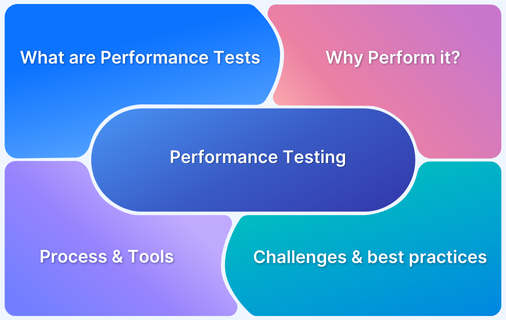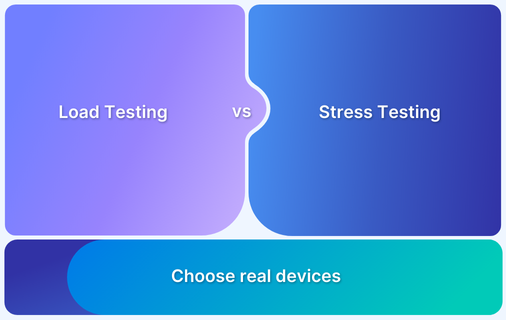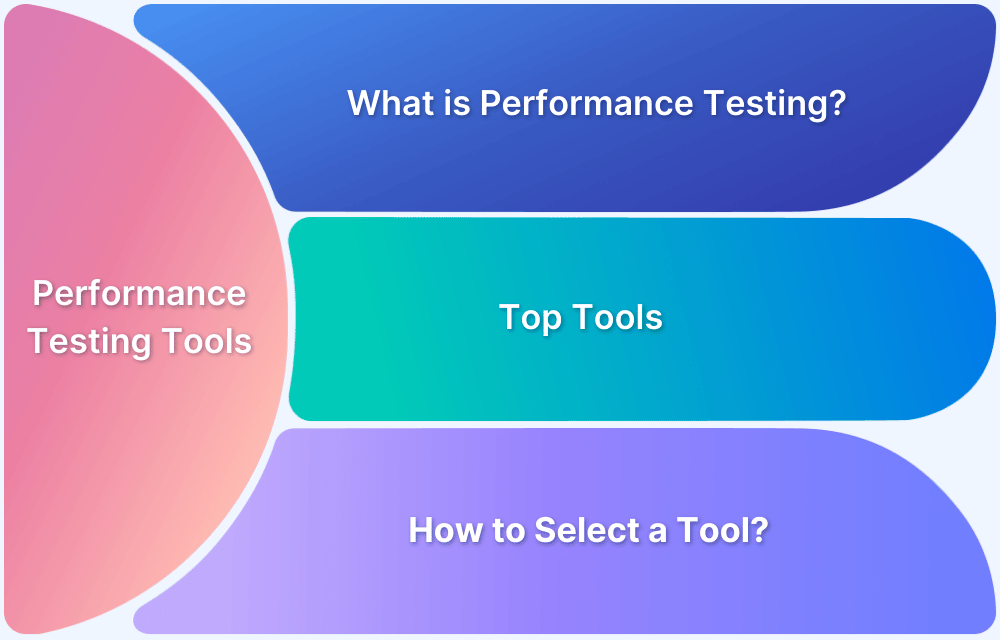In performance testing, throughput plays an important role in analyzing the number of transactions for a system within a specific duration. These metrics help calculate the system’s efficiency.
Overview
What is Throughput Performance Testing?
Throughput in Performance Testing is the measure of how much data or how many transactions a system processes in a given time
Significance of Throughput in Performance Testing
Throughput is key to understanding how well a system handles user load and operations over time. It helps identify performance bottlenecks, guides scalability decisions, and supports effective capacity planning.
Steps to Determine Max Throughput in Performance Testing
- Set targets like max TPS/RPS and thresholds for response time, error rate, and resource usage.
- Pick a tool like JMeter, k6, or Gatling based on your testing needs.
- Simulate real user behavior and vary load patterns (ramp-up, steady state, ramp-down).
- Execute tests while tracking metrics like CPU, memory, disk, and network usage.
- Identify the point where increased load no longer improves throughput and note limiting factors.
Read this guide to learn more about throughput in performance testing, its uses, examples, and implementation steps.
What is Throughput in Performance Testing?
Throughput in Performance Testing refers to the amount of data or number of transactions a system can process within a specific time period.
It is measured in requests per second (RPS), transactions per second (TPS), or bytes per second. It eventually helps to understand the load a system can handle efficiently.
Formula to measure Throughput: Total number of requests or transactions completed / Total test duration (in seconds)
Importance of Throughput in Performance Testing
Here’s how throughput helps in performance testing:
- Provides insight into the system’s ability to handle regular users and operations
- Helps in identifying performance and scalability issues
- High throughput indicates that the system can handle the load effectively, whereas low throughput shows resource constraints or inefficient code
- Allow teams to analyze the system performance against the expected standards
- Helps to support capacity planning and infrastructure scaling decisions.
Real-World Examples of Throughput in Performance Testing
Here are some of the real-world examples where measuring throughput is important for better efficiency:
- E-commerce platforms: Check the total number of checkout transactions completed per second during a Black Friday sale.
- Streaming services: Check the total number of video streams that can be run continuously without buffering.
- Banking apps: Check the total fund transfer requests that can be processed per minute during peak hours.
Also Read: Test Cases for ECommerce Website
Key Factors that Affect Throughput
Some of the main factors that affect throughput are:
- Server resources: CPU, memory, and disk I/O capabilities.
- Network bandwidth: Available bandwidth can limit throughput.
- Database performance: Query optimization and indexing impact transaction speed.
- Concurrency levels: Total number of regular users and threads running.
- Code efficiency: Backend logic and algorithm complexity.
Throughput in Different Types of Performance Testing
Here are the different types of performance testing being done to check throughput:
- Load testing: Measures throughput under expected peak load conditions. It checks how the system behaves under normal and high-traffic scenarios.
- Stress testing: Detects the system’s breaking point by increasing load until failure.
- Endurance testing: Checks the throughput consistency over an extended period. This helps detect memory leaks, degradation over time, and stability of throughput under sustained load.
- Spike testing: Tests system behavior and throughput during sudden traffic spikes. It checks how well the application recovers and maintains throughput when experiencing abrupt changes in load.
- Scalability testing: Analyzes how throughput changes as more resources are added.
How to Determine Max Throughput in Performance Testing
Here are the steps to be followed for determining max throughput in performance testing:
Step 1: Define Performance Objectives
Finalize what your target is to measure, such as maximum TPS, RPS, or data throughput.
Then, create acceptable thresholds for response times, error rates, and system resource usage.
Step 2: Select Your Testing Tool
Choose a testing tool according to your needs, such as:
- JMeter: Suitable for handling heavy loads on servers.
- k6: Ideal for scripting and running load tests with a developer-centric approach.
- Gatling: Offers a high-performance load testing feature.
Read More: Top 20 Performance Testing Tools
Step 3: Design Realistic Test Conditions
Create test scripts that replicate the actual user interactions with the system. Once you’ve done this, increase the load to observe how throughput changes with different user volumes.
Check the total duration of tests and implement different load patterns, such as ramp up, steady state, and ramp down.
Step 4: Execute Your Test and Monitor the Metrics
Start with basic tests to understand current performance levels.
- Track CPU, memory, disk I/O, and network usage during tests.
- Once all are done, observe how throughput varies with increasing load and identify issues, if any.
Step 5: Identify the Maximum Throughput Threshold
Check for the point at which increasing the load no longer results in higher throughput.
Look for indicators such as increased error rates, higher response times, or resource saturation.
At the end, record the maximum possible throughput and the conditions under which it was achieved.
Throughput vs Latency vs Response Time
Throughput, Latency, and Response time are important indicators to check the system’s performance.
- Throughput represents how much data or how many requests a system can handle within a specific period, showcasing its capacity and efficiency.
- Latency is the initial delay before a request is processed, depending on network conditions and server availability.
- Response time is the total time taken from sending a request to receiving a response.
Below is a key comparison between throughput, latency and response time.
| Aspect | Throughput | Latency | Response Time |
|---|---|---|---|
| Definition | Number of requests or data processed per second | Time taken for a request to reach the server and begin processing | Time taken from initiating a request to receiving a complete response |
| Measurement Unit | Requests per second (RPS), Transactions per second (TPS), and Bytes per second | Milliseconds (ms) | Milliseconds (ms) |
| Focus Area | System’s processing capacity over time | Initial communication and transmission delay | Complete duration including latency and backend processing |
| Use Case | Check if the system handles load efficiently | Identify network issues and delays | Assess end-user experience for system responsiveness |
| Performance Impact | Improves scalability and efficiency under load | Impacts time-to-first-byte and perceived snappiness | Analyzes how responsive the system feels to users |
| Monitoring Tools | JMeter, k6, Grafana dashboards | Wireshark, Ping tools, and network latency profilers | APM tools like New Relic, Datadog, and Dynatrace |
| Relation to Others | High throughput is ideal, but not at the cost of high latency or delays | High latency can lower throughput and increase total response time | High response time could lead to high latency and/or backend issues. |
Tools to Measure and Analyze Throughput
These are some of the most efficient tools to measure and analyze throughput:
- JMeter: An open-source load testing tool that analyzes performance under various load types. It supports multiple protocols and provides detailed throughput reports.
- K6: A modern load testing tool ideal for developers, k6 uses JavaScript to write test scripts and integrates easily with CI pipelines. It’s lightweight, fast, and great for testing APIs with throughput metrics.
- Gatling: This tool is known for its high performance and detailed insights. It is a developer-friendly tool that provides real-time metrics on throughput, latency, and errors.
- Apache Bench: It is a command-line tool that comes bundled with Apache HTTP Server, used for quick performance testing of web servers. It helps in generating basic throughput statistics like requests per second.
- Grafana: A popular open-source analytics and monitoring platform that visualizes throughput and other performance metrics. It integrates with various data sources like InfluxDB for real-time dashboards.
Also Read: What is Android Performance Testing?
Throughput Test vs Load Test
Throughput testing and load testing are both critical components of performance testing, but they focus on different performance aspects. While one emphasizes data capacity, the other measures system behavior under user load.
Here is a quick comparison between Throughput test and load test:
| Parameter | Throughput Test | Load Test |
|---|---|---|
| Primary Focus | Measures the volume of data or number of transactions processed over time. | Evaluates system performance under expected or peak user load. |
| Goal | To assess system capacity for handling data efficiently. | To analyze system behavior, stability, and responsiveness under user load. |
| Key Metric | Data transfer rate (requests/sec, transactions/min). | Response time, error rate, and resource utilization under load. |
| Use Case | Useful in high-traffic systems to determine throughput limits. | Ideal for checking performance before release or during traffic surges. |
| Insight Provided | How much work the system can handle in a given time. | How the system performs and maintains stability with multiple users. |
| Test Scenario | Simulates data-heavy usage without focusing on user interaction. | Simulates real-world user interaction patterns and load conditions. |
Importance of Real Devices in Performance Testing
Testing on real devices ensures accurate results by capturing real-world factors like hardware behavior, OS nuances, and network fluctuations, something emulators often miss.
With BrowserStack Automate, teams can test across real browsers and devices on their real device cloud to validate performance metrics like response time, latency, and throughput in real user conditions.
Key benefits of using BrowserStack Automate:
- Access to 3,500+ real devices and browsers for effective performance testing
- Automate Selenium and Cypress testing for web applications
- Real-time debugging with video logs, console logs, and network logs
- Parallel test execution to speed up performance validation
- Secure testing interface with enterprise-level data protection.
Key Challenges of Throughput in Performance Testing (With Solutions)
Some of the major challenges faced in measuring throughput in performance testing are:
- Network fluctuations during testing: Test environments face issues like inconsistent bandwidth or latency. Use a controlled lab setup or cloud-based test labs to ensure stable network conditions for consistent results.
- Server resource constraints: Limited CPU, memory, or I/O can limit throughput calculation. Scale infrastructure horizontally or vertically and optimize backend code and database queries to improve efficiency.
- Analyzing large datasets: Raw test data can never provide accurate results. So, use APM tools and performance dashboards to visualize, filter, and interpret data effectively.
- Test environment not matching production: Differences in hardware, configurations, or network between staging and production can twist the results. Test in environments that closely duplicate production steps.
Best Practices while Testing Throughput
Here are the best practices to be followed while testing throughput to get the most accurate results:
- Define clear performance goals: Establish specific throughput benchmarks, such as requests per second or transactions per minute, to align testing with business and user expectations.
- Test in an environment close to production: Simulate a real-world environment by replicating production hardware, software, and traffic conditions to generate accurate and relevant results.
- Analyze real user behavior and monitor the system with application metrics: Base test scenarios on real usage patterns and monitor system metrics like CPU, memory, response time, and error rates for a holistic performance view.
- Use a combination of testing tools: Leverage multiple tools for load generation, monitoring, and analytics to ensure comprehensive coverage and better insights into throughput behavior.
- Validate throughput under different network conditions: Test under varying network speeds and latencies (e.g., 3G, 4G, Wi-Fi) to evaluate how network performance impacts throughput and user experience.
Conclusion
Throughput is a foundational metric in performance testing, helping teams understand how well a system performs under load.
Companies can ensure their applications deliver expected and responsive user experiences by measuring and optimizing throughput, even during peak traffic.
Using the best tools to analyze throughput and following best practices can help improve system performance.






